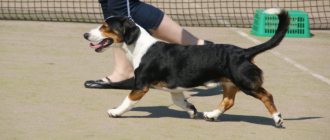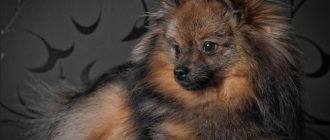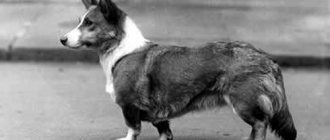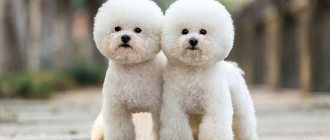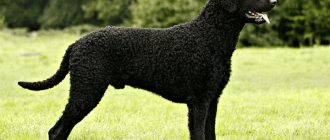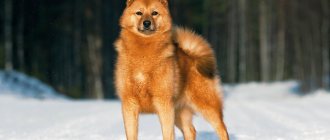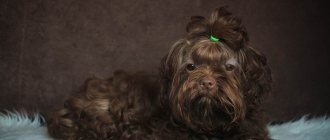Cheerful and small in size, dogs often become everyone's favorites. In families, such pets act as full-fledged members - they play with children, play sports with adults, actively demonstrating their devotion and energy. The Swedish Vallhund fits this description perfectly - a shepherd with short legs, which will not be easy to acquire.
Historical reference
Today, researchers do not have accurate data on the origin of the breed. Thus, many are inclined to believe that the ancestors appeared in the southern provinces of Sweden, where cattle breeding was actively developed. However, the external similarity with the Welsh Corgi casts doubt on whether the breed is indigenous to Sweden. During World War II, like many other breeds, Vallhunds were on the verge of extinction. With the support of the Swedish Kennel Club since 1943, the breed is considered to have been restored without losing the herding instinct. Swedish Vallhunds were recognized by the International Canine Federation in 1954 with the assignment of standard No. 14 (the current version of the document is 2013).
Description of the breed
According to the Fédération Cynologique Internationale breed classification, the Visigothic Laika belongs to the 5th group “Spitz and primitive type breeds”, the 3rd section “Northern herding dogs”. In addition to their main working purpose of herding livestock, Vallhunds excel as watchdogs and companions.
The modern Vallhund can be found among rescuers. The dogs have a keen sense of smell and are excellent at picking up scents, and their small size allows them to penetrate hard-to-reach places, which is why the Vallhund is often used for search work after natural disasters.
Appearance
Swedish Vallhunds are small in size; the height at the withers is 30–33 cm for females and 32–35 cm for males. The dog’s weight should remain between 9–14 kg. The main feature of the breed is shortened limbs. A representative of the Visigothic Spitz must have the following external parameters:
- long head with a moderately wide muzzle tapering towards the end;
- black nose;
- well-tight and dense lips;
- strong jaws;
- medium-sized eyes of dark brown color and oval shape;
- movable ears with pointed tips;
- muscular and long neck;
- smooth, strong back, deep chest;
- the tail can be of any length;
- The limbs are strong with dense oval paws.
Visigothic Spitz dogs can have either a curled tail or virtually no tail.
The standard describes important proportions for representatives of the breed:
- height at the withers relates to body length in a ratio of 2:3;
- the distance from the bottom line of the chest to the ground cannot be less than a third of the height at the withers;
- The length of the ear should slightly exceed its width at the base.
The movements of the Swedish Vallhund should be energetic, the dog runs quickly, actively moving its paws.
The coat lies close to the body, is of medium length and has a soft, well-filled undercoat. Hair extensions are allowed on the neck, chest, spine and hips. As for color, several variations are allowed:
- grey;
- gray-brown;
- grey-yellow;
- red-brown.
In the area of the muzzle, neck, chest, abdomen and buttocks there may be stripes of a lighter shade of the base color. Dark-colored hairs are usually concentrated on the back and neck. Markings on the shoulders and cheeks are desirable. White color in color is allowed only in the form of a small spot or stripe on the neck, chest and limbs.
Character and psyche of the breed
The Swedish Vallhund is an energetic, friendly and sociable dog. One of the most important working traits is vigilance - the pet will listen to any sound and even sleep in fits and starts to monitor the situation around it. The breed is characterized by excessive barking, especially in the form of a reaction to strangers, but this is corrected by education. The herding instinct often manifests itself in Vallhunds even when kept as a family. Seeing familiar animals, the dog can begin to herd them - chase them and stand up a little on his hind legs, trying to gather everyone in one direction.
When playing with children, you should immediately set boundaries. So, a dog, because of its shepherd roots, can bite babies a little, as if urging them on. Therefore, it is necessary to explain to the dog the unacceptability of such an action, and to prohibit children from running away from the pet, so as not to provoke its instincts.
The smart Vallhund easily gets along with both children and pets. But you should be careful if you have such a dog, a hamster or a pet rat - Visigothic huskies are good at catching rodents, so they may not resist temptation. The dog will definitely choose one owner and will obey him unquestioningly, associating him with his family.
Swedish Vallhunds are active and playful and enjoy spending time outdoors.
When training, it is important to take into account the animal’s temperament. Visigothic Spitz dogs require constant physical and mental activity; they need to be occupied with active games, exercises and training. Otherwise, the pet will behave destructively - not at all because of harmfulness or mischief, but solely because of the desire to relieve stress.
The Swedish Vallhund will happily hunt using its sensitive sense of smell if the owner is interested in this activity.
Disqualities and disadvantages
Even a slight deviation from the requirements described in the standard is already a minus for a particular animal, which will affect its assessment by specialists. The more seriously the deviation from the norm affects the dog’s condition and appearance, the more it affects the assessment. The following are considered serious disadvantages:
- the distance from the bottom line of the chest to the ground is too small;
- lack of a clearly defined transition from the forehead to the nose (foot);
- light eyes;
- low-set ears;
- excessively wide chest;
- steep shoulder line;
- short shoulders;
- rounded skull or muzzle;
- weak lower jaw;
- soft, spiky or long hair;
- lack of undercoat;
- more than 30% white in color;
- significant deviation from the required height at the withers.
The following deviations from the standard are grounds for removing an animal from exhibition and breeding work:
- behavioral disorders (the dog is too aggressive or overly shy);
- malocclusion;
- Blue eyes;
- drooping or bent ears;
- long curly coat;
- black, white, brown or blue coat color.
Appearance
The Swedish Vallhund is a small, strong, short-legged dog of an elongated format. The ratio of body height and length is 2:3. The distance from the bottom of the chest to the ground is at least 1/3 of the total height at the withers. Sexual dimorphism is well expressed. Height at the withers of males - 32-35 cm, females - 30-33 cm.
The skull is relatively wide, tapering evenly towards the nose. The head is quite long. The lines of the muzzle and skull are parallel. The stop is well defined. The nose is black. The muzzle is shaped like a blunt wedge, slightly shorter than the skull. The lips fit tightly. The jaws are well developed and strong. Scissor bite. The eyes are oval, medium size, dark brown. The ears are medium size, erect, pointed. The auricle is covered with smooth hair and is mobile. The length of the ears is slightly greater than the width at the base.
The neck is flexible, long, with well-developed muscles. The back is straight. The loin is wide, strong and short. The croup is wide, slightly sloping. The chest is long, deep with well sprung ribs, lowered to 2/5 of the length of the forelimbs. The lowest point is behind the elbows. The belly is slightly tucked. Limbs with strong bones, relatively short. The paws are oval, short, directed forward, of medium size. The pads are strong. The fingers are bunched up and arched.
There are two types of tail in the breed:
- With a long tail (tail of any length);
- Boobtails.
The coat is double, consisting of a medium-length outer coat, coarse, lying close to the body and a soft, very dense undercoat. The hair on the head and the front side of the limbs is short. Long on the neck, chest, throat, back of the thighs. Wolf (zonal) color of various shades:
- Grayish-brown;
- Yellowish-brown;
- Reddish-brown.
Lightened areas are required on the face, around the eyes, limbs, torso and lower part of the neck.
In Canada and America, they take a more simplified approach to possible colors. There, at exhibitions you can meet two-color and one-color Vallhunds.
Choosing a puppy
The Swedish breed is highly valued in its homeland, so the main nurseries are located in the Scandinavian countries. Vallhunds are also popular in the USA, Canada, Australia and New Zealand. The breed is not numerous, and hard work is still being done to preserve the typical exterior and temperament during breeding, so it is quite difficult to buy a puppy. The easiest way to find a breeder is through the Visigothic Spitz Association in Finland or Sweden.
You can distinguish a purebred puppy only by one reliable sign - the presence of a pedigree. Without this document there can be no guarantee that a particular puppy belongs to the Swedish Vallhunds. The cost of the baby is quite high - about 1000 euros.
The average cost of a Visigothic husky puppy is 1000 euros
Offspring
Vallhunds are not very common in Russia, so finding a purebred puppy is very problematic. Since this breed does not have characteristic features at an early age, in order to avoid unexpected “surprises” in the form of a yard dog or a mixed breed, it is better to buy a pet in nurseries or from bona fide breeders.
When meeting your baby, you should pay attention to his general condition, which should not have signs of any health problems. You should take a cheerful, active and sociable puppy
Pedigree, age-related vaccinations and veterinary passport are required.
Interesting fact
They say about Vallhunds - cute like a corgi, formidable like a wolf.
The average price of a Visigothic husky puppy is 30-50 thousand rubles.
Mating
The first mating in females begins at 6-8 months. The optimal age for mating is 1.5-2 years.
Before mating, the couple is introduced on neutral territory, but mating is carried out only on the second day in the morning and on the territory of the male dog. Before this, the dogs need to be given a good walk, but not fed. Usually the animals stay in the castle for 15-45 minutes.
Re-mating is carried out after 24-48 hours. The duration of pregnancy is 2-2.5 months, there are 4-5 puppies in the litter.
Caring for the Visigothic Laika
Vallhunds are small dogs and can easily feel comfortable with their owner in a city apartment. But still, the best option for an animal would be a house with a private territory, where the animal could play for a long time and actively. Regardless of the type of home, the animal must be taken out for a long walk every day - at least 2-3 hours of exercise is required. It is advisable that at least one family member is at home all the time - such an active and family dog should not be left to its own devices for a long time.
Caring for a pet involves:
- Feeding. The food must meet the high energy consumption of an active shepherd, so when choosing natural food, you need to create a diet together with a specialist. It will definitely include fresh lean meat, dairy products and vegetables. But sweets, flour, fatty, smoked and bones will be prohibited, as for any other dog. The commercial diet should be intended for medium-sized breeds with high activity (Acana Heritage Sport Agility, Monge Dog Specialty Active, Brit Care Endurance Duck Rice, etc.).
- Grooming. Short and dense fur requires a minimum number of treatments; brushing once a week will be enough (with the exception of the spring-autumn molting period - then the pet will have to be brushed daily). The cover repels water and dirt well, so after a walk it is enough to wipe off the dirt with a damp towel. You don’t need to bathe your dog often, 2-3 times a year is enough.
To care for the Vallhund's short hair, you will need a special brush.
- Caring for ears and claws. With regular walking, there is no need to trim the nails, but the ears need to be inspected daily and if dirt is found, be sure to wipe it.
When training a dog of this breed, it is important to abandon harsh correction methods - harsh actions give a poor response from representatives . Vallhunds respond best to positive reinforcement, especially treats. Behavior is studied in two directions:
- general obedience, particularly bark control;
- early socialization, familiarity with new surroundings, people and animals.
Diseases of the Swedish Vallhund
The Swedish Vallhund is a dog with northern roots, so it has fairly good health and adapts well even to harsh environmental conditions. Life expectancy with proper care is 12–14 years. When buying a puppy, you should pay attention to the health of its parents, since the breed most often has ailments that are of a hereditary nature:
- Hip dysplasia. Congenital pathology of the development of the pelvis leads to chronic dislocation, which causes pain and does not allow the animal to move normally. Having discovered that your pet is pressing its back paw and has stopped actively playing, you need to go to the hospital - the only solution to the problem is surgery.
- Retinopathy (damage to the retina). The main symptom is a noticeable deterioration in vision. If left untreated, the disease progresses and leads to blindness. The veterinarian can prescribe either medication to treat the problem or surgical intervention - everything will depend on the severity of the case.
Video: Swedish Vallhund at an exhibition
The Swedish Vallhund is an active and loyal animal that learns quickly and loves its owner. Getting a purebred puppy is quite difficult, since the breed is small in number and distributed mainly in its homeland - Sweden. These pets are unpretentious in caring for and do not require special skills from the owner.
- Author: Alena Lomakina
Hello! My name is Alena, 26 years old. For many years I have been dealing with issues of family, health and raising children. I have a higher psychological and economic education. Great interest in our little brothers has given rise to a new branch of my activity - the study of topics related to domestic animals.
Rate this article:
(1 vote, average: 5 out of 5)
Thanks to the Swedish Vallhund, or in other words, the Visigothic Spitz, it becomes clear that for a real, working shepherd, neither height nor weight is important. After all, this short-legged dog once perfectly coped with entire herds, destroyed hordes of rats and guarded both livestock and homes. And, in addition, the Swedish Vallhund has always been an excellent companion, faithful and devoted. Unfortunately, today the breed is not very widespread, but true connoisseurs of these amazing Spitz dogs are engaged in maintaining it and preserving the unique breed qualities and exterior.
Categories
- Almanac (208)
- Analytics (122)
- Jokes (74)
- Astronomy (88)
- Airport (90)
- Business youth (149)
- Our smaller brothers (100)
- Future (147)
- Wind of wanderings (95)
- Age of youth (140)
- Questions and Answers (133)
- Time forward (248)
- Know everything, talk and be smart (218)
- Universe
Space (59)(136)
- Gallery (58)
- Guide (225)
- Longevity (132)
- Animals (98)
- Health and youth (187)
- Knowledge and experience (179)
- Information (184)
- Collection of absurdities (102)
- Consultation (172)
- Chronicle (144)
- Personal (88)
- Store (41)
- Medicine (294)
- Opinion (130)
- Youth is time (79)
- Thoughts out loud (218)
- Real estate (58)
- News feed (251)
- Lifestyle (225)
- Society (244)
- Anti-aging cosmetics (57)
- Body rejuvenation (31)
- Technology Parade (95)
- Nutrition and diets (115)
- Planet earth (62)
- Positivity platform (73)
- More smiles (249)
- Good to know (506)
- Polyglot (61)
- Politics (205)
- Show your evidence (121)
- Journey into history (216)
- Traveling easily (126)
- Miscellaneous about food (102)
- Plants (41)
- Religion (95)
- Repair and Construction (77)
- Solving the problem together (60)
- Website youth (274)
- Youth salon (180)
- Secrets of Slimness (77)
- Word to science (229)
- Events (240)
- The Mystery of Youth (106)
- Tourism (171)
- Interests and hobbies (179)
- Amazing is nearby (274)
- Ukraine Russia (211)
- Photo album (231)
- Quotes-quotations (71)
- What does it cost us to build a house (115)
- Energy (50)
- I love you too (105)
Origin of the breed
For historians and dog handlers, the history of the origin of the Swedish Vallhund still raises a lot of questions. According to one version, these dogs, reminiscent of Welsh Corgas, ended up in Britain with the Vikings; according to another, Vallhunds descended from Pembrokes, who somehow appeared in Sweden.
The homeland of these Spitz is the Visigothic Valley, which is located between two lakes - Vänern and Vättern. In this place, since ancient times, people have been engaged in cattle breeding, and they have always been helped by dogs - corgis, spitz, huskies. Experts admit that some of these species were the ancestors of modern Visigothic Spitz.
During World War II, the breed, like many others, was on the verge of extinction. However, lovers of these extraordinary dogs, Zettersten and Bjorn, using their own program, began to restore them. They succeeded, but still they did not gain worldwide popularity. Today, no more than two hundred individuals of this breed are registered in their homeland, and the breed club includes about 600 members.
general information
Today the popularity of this breed is depressingly low. However, it is often confused with its more famous relative, the Norwegian Elkhound. However, in terms of the range of its external and internal qualities, the emthund is in no way inferior to it.
With their wolfish appearance and coloring combined with a dog's devotion, Swedish Huskies make the perfect companion dog, and hunting enthusiasts will be delighted with these energetic and intelligent dogs. They also have a lot of courage. The ancestors of the Emthunda, without hesitation, entered into battle not only with elk and lynxes, but also with such a terrible and strong predator as a bear.
At the same time, many dog handlers note the amazing devotion of these dogs to their owner. Even for huskies, the “Swedes” are ready to literally do anything for him. This is historically quite reasonable and deserves admiration.
Description of the Swedish Vallhund breed
Vallhunds were used as cattle dogs, and they were excellent at it. Already at that time, the selection of dogs was carried out exclusively on working qualities, and breeders did not pay much attention to the exterior. So the modern representative of the breed does not have a bright appearance and is more attractive with its character and excellent physical characteristics.
If you look at the standard, the Visigothic Spitz is a physically strong, medium-sized, squat dog, brave, with a lively character. Already at one glance it is clear that the Vallhund is brave, attentive, and energetic. The weight of representatives of the breed does not depend on gender; it varies from 9 to 14 kg. The height of males is 31.5-34.5 cm, females - 29.5-32.5 cm. But it is worth considering that the expert commission takes into account the dimensions only after assessing the proportionality of the individual’s build.
The standard describes the dog as follows:
- The head is in the form of an elongated wedge; when viewed from the side, it is blunt, the silhouette is symmetrical, even, and the lines are clear. The forehead is wide, flattened, the stop is well defined. The lips are moderately thick, close fitting and fully pigmented.
- The jaws are strong, with a full set of teeth forming a regular, scissor bite. The lobe is a rich black shade, with well-opened nostrils.
- The eyes are oval-shaped, small, and the iris is dark brown.
- The ears are medium in size, hard, thick, set low, and rounded at the ends. The ear cartilage is triangular.
- The body is stocky, with a visually elongated neck, set at a natural angle and oval in cross-section. The withers are moderately pronounced, merging into a level line of the back and a muscular, straight loin. The croup is shortened, with neatly rounded lines and sloping, but all proportions are preserved.
- The sternum is elongated, oval in shape, falls just below the elbow joints, moderately wide, with arched ribs. The groin line is tucked, but without excessive dryness.
- The limbs have pronounced, strong bones, a natural set with a slight bevel. The forelegs are stable, with sloping shoulder blades and shortened forearms. The elbows and shoulders are close to the sternum, but are free during movement. The pasterns are without eversion and are strong and flexible. The rear ones are spaced slightly wider than the front ones. The thighs are well muscled and proportional. The lower legs are longer than the metatarsals, the hocks are not heavy, and are located parallel. The brushes are medium-sized, short, oval, collected in a lump. The pads are covered with strong, thick skin, the claws are darkly pigmented and durable.
- The tail may be naturally short or of natural length and cannot be docked. When assessing its size, they do not pay attention; it is important that it does not have any creases and carries itself confidently.
Coat quality and possible colors
The Swedish Vallhund has a double coat - hard guard hair and a very thick, dense undercoat. Thanks to this protection, the dog is not afraid of winds and severe frosts.
There are individuals with plain gray fur, gray with brown, red with brown, gray with yellow. Individuals with a two-color coat have additional black hair. White hair is not typical for dogs of this breed, but the standard allows its presence on the face, collar, and sternum in the form of small spots.
Vallhunds who have a lighter than the main coat pattern in the form of a harness in the area of the shoulders and back are more likely to receive the highest rating.
Appearance
The Norwegian Elkhound is a typical Spitz with a compact short body, erect ears, thick, abundant hair and a tail curled over the back. Sexual dimorphism is well expressed. Height at withers:
- Gray elk husky - 49-52 cm;
- Black moose husky - 43-49 cm.
The skull is wedge-shaped, relatively flat between the ears. The cheekbones are prominent. Stop is expressed moderately. The muzzle tapers gradually towards the black nose. The bridge of the nose is straight. The lips fit well. Scissor bite. The eyes are dark brown, non-protruding. The ears are set straight and high, small, pointed, very mobile. The width of the ears at the base is slightly less than the height.
The body is strong and durable. The topline is straight. The withers are well developed. The back is straight and strong. The croup is wide and strong. The chest is deep, wide, with curved ribs. The underline is almost straight. The tail is set high and relatively short. Screws tightly and sits on the center line of the top without leaning to any side. The legs are strong, strong, straight, and dry. The paws are relatively small, compact, with well-knit and forward-pointing toes.
Black and gray Norwegian Elkhounds look very similar, however they are two different breeds. The black moose husky has a tougher disposition, its coat is shorter, its size is smaller, its body is lighter and less compact.
The coat is medium length, coarse, thick. The guard hair is abundant, without curls. On the front side of the legs and head the hair is smooth and short. Long on the neck, back of the limbs, hips, and tail. The undercoat is soft and dense. Color:
- The gray Elkhound has various shades of gray. Guard hairs with black tips. On the chest, belly, legs, lower part of the tail, under the tail, and on the harness-shaped body, the hair is lighter. From the withers to the elbows, the top of the tail is darkest. The ears and the front of the head (mask) are also dark. A dark line runs from the eyes to the base of the ears. The undercoat is always light gray.
- The black Elkhound has a glossy black color. Small white markings on chest and paws are allowed.
Character and disposition
A short description of this squat Shepherd is that it is an affectionate, energetic, alert dog. She needs active games and walks to maintain excellent physical shape and expend excess energy. Spending a long time indoors alone will not benefit your pet.
Modern Vallhunds are practically not used for herding livestock, but these small, restless dogs are found among rescuers. Thanks to their keen sense of smell, dogs are excellent at picking up scents, and their modest dimensions allow them to penetrate hard-to-reach places. Therefore, representatives of this breed are often used for search activities, which are carried out after a disaster.
The Swedish Vallhund is very devoted to his family and is friendly towards all members of the household. He can greet guests warily, but without displays of aggression. Such a positive and active pet is capable of infecting those around him with his cheerfulness, but will never impose his company if he sees that the owner has no time for him.
Vallhund and children are the perfect combination. Of course, you will have to forget about peace and quiet, but this company will find a way to spend their free time - fun and active. The main thing is to stop the “madmen” in time, otherwise all the pieces of furniture in the apartment will be turned upside down.
At the same time, the dog is balanced and is not an easily excitable animal. But there is one peculiarity - unsterilized dogs during “dog weddings” will try in every possible way to be participants in such an event. The Spitz is friendly towards other animals, but its playfulness may not please other inhabitants of the house, for example, cats.
A former shepherd, the modern Spitz is a companion who adores his owner and is very bored when apart. If the owner needs to leave the pet with strangers, then it is worth knowing that the dog can experience severe stress and even fall into a painful apathetic state. Therefore, if there is even the slightest opportunity to take a four-legged friend with you, it is better to do so. He will handle the trip well, and will behave as civilly and politely as possible, trying not to cause unnecessary trouble.
Owner reviews
Vera K.: “Our house is like a passageway; my husband’s colleagues and friends of our school-aged son come in. Grisha (Swedish Vallhund) is wary of everyone at first, but literally from the second meeting he establishes contact, especially with those who we like the most.”
Denis P.: “Dogs of this breed cannot be bathed often, but ours loves to walk in any weather, and gets dirty accordingly. I bought him a dog raincoat, he wears it without whims.”
Ella F.: “With this dog, my children are always busy - they have common games, laughing throughout the whole house.”
Training and education
The Swedish Vallhund is an intelligent, understanding, easily trained dog that is excellent at communicating. And, besides, he is ready to do anything, just not to get bored at home. But if the owner does not educate and train his pet, then in the future he will have to face his willfulness and love of freedom. This trait is common to most herding breeds, and the Swedish Vallhund is no exception.
Another nuance is that once upon a time these dogs had to make their own decisions, and today Vallhunds have a clearly expressed this trait. If the owner does not prove his leadership and does not show the pet that his opinion is 100% correct, he can solve the problem in his own way. It is advisable for the owner to distinguish whether the dog is stubborn or whether he is coping with the problem in his own way, since the dog may not understand why he is being punished.
During training, the owner and the pet must treat each other with confidence; they must not shout or offend the dog, as the Vallhund may not only be offended, but also completely refuse to participate in the process. The dog is responsive to praise, always happy for a treat, and if at the end of classes you devote a little time to play, he will be simply happy.
Care and health features
The Swedish Vallhund is one of the most unpretentious pets. The dog is combed infrequently, 3-4 times a month, only during molts the number of procedures will have to be increased.
It is not recommended to bathe representatives of this breed frequently, as this will negatively affect the quality of the coat and the condition of the skin, and deprive them of their natural protective lubricant. It is enough to wash your pet 3-4 times a year. To keep the coat clean longer, during rainy weather it is advisable to wear a special raincoat on your pet.
The rest of the care includes standard hygiene procedures:
- teeth are naturally strong and white, and remain so until old age if they are regularly cleaned of plaque and tartar. For preventive purposes, you can give your dog large beef bones or dental treats from time to time;
- claws - if the owner regularly walks his pet and spends at least an hour and a half a day on this, then the dog’s claws wear off on their own, otherwise they should be trimmed with a nail clipper;
- eyes - constantly inspected for accumulations of dirt and tear fluid in the corners; if contamination is detected, they should be cleaned using a chamomile decoction;
- ears - if dirt and plaque appear, you can wipe them with a damp cloth, but so that the liquid does not get into the ear canal.
Diseases of the breed
On average, Visigothic Spitz live from 12 to 14 years, and if the dog is purebred, has good genes and receives proper care, then he may not get sick at all until old age. Most Vallhund diseases are hereditary pathologies, so future owners are recommended to purchase a puppy from a good nursery that provides documents stating that the parents of the offspring do not suffer from genetic diseases.
Most older dogs have a weak point in the eyes, and although a Visigoth with good genetics is not prone to developing cataracts or glaucoma, with age he may develop retinal atrophy or multifocal retinopathy.
In addition, a stocky physique, which is a breed feature, can cause various diseases of the musculoskeletal system in an older Spitz, and most often this is dysplasia of large joints.
The list of inherited diseases also includes the following pathologies:
- hyperextension;
- myelopathy.
Links[edit]
- "Hundrasguiden/Svenska-raser" (PDF). www.skk.se.
- ^ ab Club, American Nursery. "Swedish History and Vallhund Training/Temperament". www.akc.org
. Retrieved October 13, 2016. - ^ abc "History of the breed | SVCA, Inc." www.swedishvallhund.com
. Retrieved January 16, 2022. - ^ ab Swedish Vallhund Society (2016). Breed standard
[Online]. Available at < https://www.swedishvallhunds.co.uk/index.asp?pageid=399181 > (accessed 16 April 2016). [1] - Club, American Nursery. "Swedish information about the Vallhund dog breed".
- "Breed standard - Swedish Vallhund". Archived from the original on 2010-05-24. Retrieved December 6, 2010.
- Article from the dog breed gallery about pedigree
- Cooper, Anne E.; Ahonen, Saija; Rowlan, Jessica S.; Duncan, Alison; Seppälä, Eija H.; Vanhapelto, Paivi; Lochy, Hannes; Komaromi, Andras M. (September 8, 2014). "A new form of progressive retinal atrophy in Swedish Vallhund dogs". PLOS ONE
.
9
(9):e106610. Bibcode: 2014PLoSO...9j6610C. DOI: 10.1371/journal.pone.0106610. PMC 4157785. PMID 25198798 - via PLoS logs. - Hartnagle-Taylor, Jeanne Joy; Taylor, Ty (2010). Stockdog Savvy
. Alpine Publications. ISBN 978-1-57779-106-5.
Feeding
The Swedish Vallhund is not a picky dog - he will eat everything that comes into his bowl. But the owner should remember that the health and life expectancy of his four-legged friend depend on nutrition.
When feeding naturally, the dog must receive food containing animal protein - meat and offal; they can be replaced with low-fat sea fish a couple of times a week. The offal is pre-boiled, but the meat is given raw or scalded with boiling water. It is useful to give your dog raw tripe.
Your pet's menu should also include vegetables, fruits, eggs, fermented milk products (cottage cheese, kefir), and porridge seasoned with vegetable oil. You can give your dog fish oil or flax oil as a nutritional supplement. You should not treat your pet to food from your table, and especially not give him pickles, marinades, smoked meats, flour and confectionery products.
In winter and spring, it is recommended to give the dog vitamin and mineral complexes. It is advisable to consult a veterinarian on this issue.
The owner can feed the dog commercial diets, but it must be a high-quality premium or super-premium product, suitable for active small dogs.
Nutrition
These Spitz dogs are not at all picky about food. They tend to eat whatever is put in their bowl. But you should never forget that these dogs are still predators, and it is harmful for them to feed only plant foods. The basis of feeding these animals is meat food, but it should not contain a lot of fat.
It will be most beneficial to feed them raw meat from calves, lamb, rabbit and turkey. All this should be cut into small pieces and given to the dog. There is no need to mince the meat, because in this form it does not benefit the dog’s body. It is very advisable to give your pets products that accompany the processing of meat carcasses - tripe, kidneys, lungs, heart. In some cases, they can be completely fed to the dog instead of meat.
It wouldn’t hurt to treat your animal to freshly frozen ocean fish several times a week. Diversify your dog's menu with vegetables, fruits, and herbs. First, they should be grated raw and then fed to your pet. It is also required to provide food of fermented milk origin.
You should constantly pour water into the bowl. It is forbidden to feed Vallhunds with food that people themselves eat, and you cannot give them a lot of sweet food. It is allowed if they can enjoy cheese, carrots, and apples.
Puppy cost
Dogs of this breed are very rare in Russia, so finding a pet can be very problematic. Most often, future owners have to turn to foreign breeders. The most active breeding of West Goth Spitz dogs is in Sweden and Finland. But in this case, you will have to take into account that delivering the baby can be quite expensive. In addition, the cost of foreign offspring is usually higher than domestic ones.
The average price for Swedish Vallhund puppies varies from 30,000 to 50,000 rubles. Naturally, you will have to pay more for a dog from titled parents who is allowed to participate in exhibitions and breeding than for a baby who is only suitable as a pet with no further prospects. In some cases, sellers put a higher price on females.
It is not recommended to purchase a puppy without a pedigree; the risk of buying a mixed breed or a yard dog is high, since representatives of the breed do not have any distinctive features that appear at an early age. It is even more dangerous to buy a puppy with poor genetics and heredity, which will entail huge health problems.
The Swedish Vallhund is a pet suitable for active people who have free time, and most importantly, a desire to spend it with their energetic, short-legged pet. The dog will happily participate in the life of the owner, love him boundlessly and delight him.
general characteristics
The Swedish Vallhund has the following breed parameters: height (height at the withers) ranges from 33 to 40 cm (males should be slightly taller than females); weight is within 9-14 kg. The proportion of the dog's height and oblique body length is approximately 2:3. This breed belongs to the Spitz breed. The Vallhund lives 14-16 years.
In 1991, the Vallhund standard was approved. The color can be gray, gray-yellow or brown, the back and neck are always darker; the chest and paws may have white spots.
Initially, the Swedish Vallhund was intended for herding livestock, but it can also be used as an excellent guard dog, and in our time even as a rescue dog. It is distinguished by its tenderness towards children.
